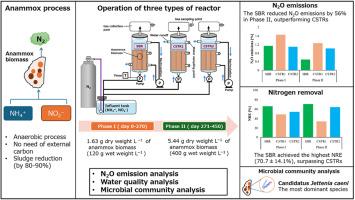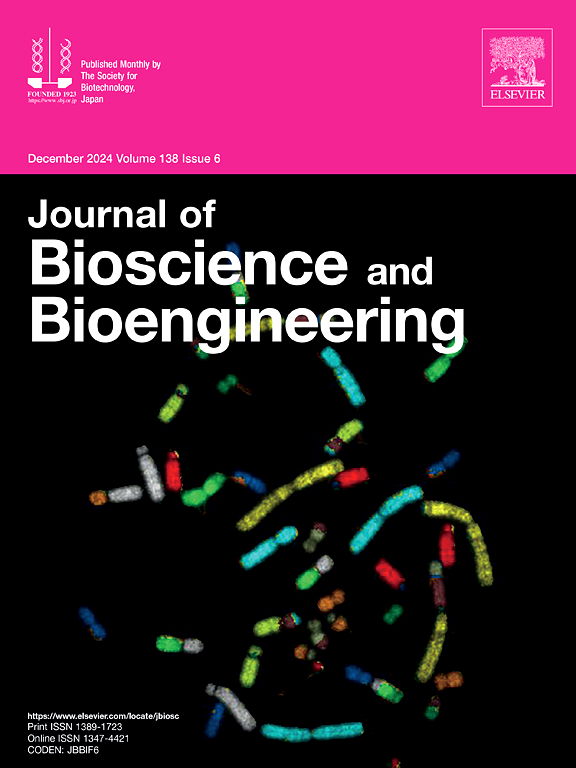Nitrogen removal and N2O emissions in anammox reactors: Influence of reactor design on process performance and microbial communities
IF 2.9
4区 生物学
Q3 BIOTECHNOLOGY & APPLIED MICROBIOLOGY
引用次数: 0
Abstract
The assessment and mitigation of N2O emissions from anammox-related processes is challenging for environmentally friendly wastewater treatment. This study evaluated the nitrogen removal efficiency (NRE), N2O emissions, and microbial diversity in three laboratory-scale anammox reactors: a sequencing batch reactor (SBR) with a recirculation line, a continuous stirred tank reactor (CSTR) without a recirculation line (CSTR1), and a CSTR with a recirculation line (CSTR2). Across two operational phases with anammox biomass (dry weight) of 1.63 g L−1 (phase I) and 5.44 g L−1 (phase II), the SBR had a higher NRE and lower N2O emissions than the CSTRs. The NREs in phase II were 70.7 ± 14.1 % for the SBR, 68.9 ± 15.7 % for CSTR2, and 41.9 ± 15.8 % for CSTR1. N2O emissions from the SBR were reduced by 56 % in phase II relative to phase I. Microbial diversity declined, and community composition shifted during reactor operation. In phase II, the Shannon entropy indices were 4.77 (SBR), 4.61 (CSTR2), and 5.04 (CSTR1); higher diversity in CSTR1 correlated with lower anammox abundance and thus lower performance. Candidatus Jettenia caeni became the predominant anammox species. Gene analysis revealed a positive correlation between the abundance of anammox-specific 16S rRNA genes (targeted by Amx809f/Amx1066r) and NRE, while nirS and nirK gene copy numbers were inversely related to reactor performance (NRE and N2O emissions). The copy numbers of nosZ genes (clade I and clade II) varied in phase II across different reactors, which potentially contributed to the differences in N2O emission reductions observed during this phase.

厌氧氨氧化反应器中的氮去除和N2O排放:反应器设计对工艺性能和微生物群落的影响。
评估和减少厌氧氨氧化相关工艺产生的N2O排放对环境友好型废水处理具有挑战性。本研究对3个实验室规模的厌氧氨氧化反应器进行了氮去除效率(NRE)、N2O排放和微生物多样性的评估,这3个反应器分别是:带循环线的序批式反应器(SBR)、不带循环线的连续搅拌槽式反应器(CSTR) (CSTR1)和带循环线的CSTR (CSTR2)。在厌氧氨氧化生物量(干重)分别为1.63 g L-1(一期)和5.44 g L-1(二期)的两个运行阶段,SBR的NRE高于cstr, N2O排放量低于cstr。二期NREs分别为SBR 70.7±14.1%、CSTR2 68.9±15.7%、CSTR1 41.9±15.8%。与第一阶段相比,第二阶段SBR的N2O排放量减少了56%,微生物多样性下降,群落组成在反应器运行过程中发生了变化。二期Shannon熵指数分别为4.77 (SBR)、4.61 (CSTR2)和5.04 (CSTR1);CSTR1多样性越高,厌氧氨氧化丰度越低,生产性能越差。候选热氏菌(Candidatus Jettenia caeni)成为厌氧氧化菌的优势种。基因分析显示,厌氧氨氧化特异性16S rRNA基因(Amx809f/Amx1066r靶向)的丰度与NRE呈正相关,而nirS和nirK基因拷贝数与反应器性能(NRE和N2O排放)呈负相关。nosZ基因(进化枝I和进化枝II)的拷贝数在不同反应器的第二阶段有所不同,这可能导致该阶段观察到的N2O减排差异。
本文章由计算机程序翻译,如有差异,请以英文原文为准。
求助全文
约1分钟内获得全文
求助全文
来源期刊

Journal of bioscience and bioengineering
生物-生物工程与应用微生物
CiteScore
5.90
自引率
3.60%
发文量
144
审稿时长
51 days
期刊介绍:
The Journal of Bioscience and Bioengineering is a research journal publishing original full-length research papers, reviews, and Letters to the Editor. The Journal is devoted to the advancement and dissemination of knowledge concerning fermentation technology, biochemical engineering, food technology and microbiology.
 求助内容:
求助内容: 应助结果提醒方式:
应助结果提醒方式:


